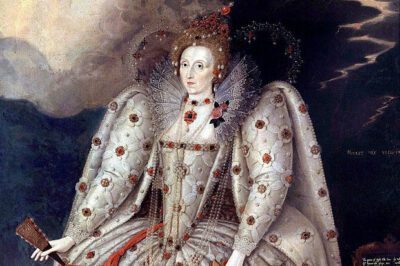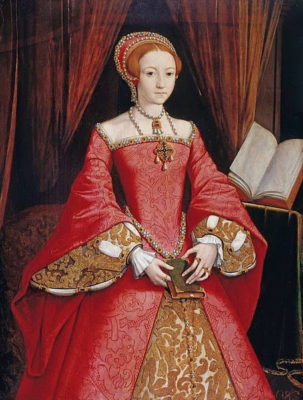داستان انگلیسی الیزابت اول : دختر هنری هشتم
با سلام خدمت همراهان همیشگی موسسه فرساد. تا امروز درباره داستان انگلیسی هنری هشتم و سه همسرش صحبت کردیم. امروز درباره دختر وی ؛ الیزابت اول؛ صحبت خواهیم کرد:
الیزلبت اول انگلستان
(متولد7سپتامبر1533-وفات24مارچ1603)
الیزابت از سال 1558میلادی تا به هنگام مرگش پادشاه ایرلند و انگلستان بود.الیزابت را به لین دلیل که هرگز ازدواج نکرد ملکه باکره نیز می نامند.او پنجمین و آخرین پادشاه از دودمان تیودور بود.الیزابت فرزند هنری هشتم(که شش همسر اختیار کرد) و آن بولین بود.
اما هنگامی که تنها دو سال و نیم بیشتر نداشت مادرش (ان بولین)به دستور پادشاه(هنری هشتم)اعدام شد و الیزابت به عنوان فرزند نامشروع پادشاه شناخته شد.پس از مرگ هنری ادوارد ششم به سلطنت رسید و پس از او طبق وصیت ادوارد لیدی جین گری باید وارث تاج و تخت میشد و ادوارد با این کار دست دو خواهر ناتنی اش را(الیزابت و مری)که کاتولیک مذهب بودند را از سلطنت کوتاه کرد.

اما این امر مغایر با قانونی بود که پارلمان انگلستان تصویب کرده بود بنابر این ارزش این وصیت از بین رفت والیزابت و مری برای جانشینی پس از ادوارد قرار گرفتند.پس از مرگ ادوارد مری جانشین شد و لیدی جین گری اعدام شد.
در سال 1558
الیزابت به جای خواهرش مری که حدود یک سال و نیم از سلطنتش می گذشت و به ظن حمایت از شورشی های پروتستان ها زندانی شده بود به سلطنت رسید.الیزابت سلطنت خود را با مشاوره خوب مشاورینش اغاز کرد این مشاورین که توسط ویلیام سیسیل رهبری میشدند تا حدود زیادی بر الیزابت تسلط داشتند و الیزابت نیز به همچنین بسیار بر آن ها متکی بود.
اولین کار او
این بود که یک کلیسایی پروتستانی بر پا داشت و همگان انتظار داشتند الیزابت پس از مدتی ازدواج کند و خاندان تیودور را با به دنیا اوردن یک وارث سلطنتی تداوم دهد اما الیزابت علی رغم چندین معاشقه هرگز این کار را نکرد.الیزابت در دولت مداری اش نسبت به خواهران و برادران ناتنی اش و والدینش میانه رو تر بود.شعار مشهور او این بود که می بینم و هیچ نمی گویم و از آزار و اذیت سازمان یافته مذهبی تا حد امکان پرهیز می کرد .
هنگامی که پاپ الیزلبت را نامشروع خواند(1570م)و پیروان او را از حمایت و اطاعتش منع کرد چندین توطئه علیه او صورت گرفت که همگی نیز با کمک وزرا با شکست مواجه شدند.در ارتباطات خارجی محتاط عمل می کرد وبا دو ابر قدرت ان زمان(فرانسه و اسپانیا)در روابطش تعادل را بر قرار می کرد در سال 1580 که جنگ با اسپانیا اجتاب ناپذیر شده بود الیزابت با به حرکت در اوردن نیروی دریایی قدرتمندش و شکست اسپانیا یکی از بزرگترین پیروزی های انگلستان در طول تاریخ را ثبت کرد.
دوران سلطنت الیزابت به عصر الیزابت مشهور بود و او از پیشگامان تاتر و موسیقی حمایت می کرد.در اواخر سلطنتش یک سری از مشکلات سیاسی نظامی و اقتصادی از محبوبیت او کاست.الیزابت پادشاهی مقتدر بود اما این مورد درباره ماری اسکاتلند نیز صدق می کرد اما الیزابت او را دستگیر و او را اعدام کرد در دوران 44 ساله الیزابت انگلستان ثبات یافت و به یک کشور مقتدر تبدیل شد.
Elizabeth I
– the last Tudor monarch – was born at Greenwich on 7 September 1533, the daughter of Henry VIII and his second wife, Anne Boleyn.
Her early life was full of uncertainties, and her chances of succeeding to the throne seemed very slight once her half-brother Edward was born in 1537. She was then third in line behind her Roman Catholic half-sister, Princess Mary. Roman Catholics, indeed, always considered her illegitimate and she only narrowly escaped execution in the wake of a failed rebellion against Queen Mary in 1554.
Elizabeth succeeded to the throne on her half-sister’s death in November 1558. She was very well-educated (fluent in five languages), and had inherited intelligence, determination and shrewdness from both parents.
Her 45-year reign is generally considered one of the most glorious in English history. During it a secure Church of England was established. Its doctrines were laid down in the 39 Articles of 1563, a compromise between Roman Catholicism and Protestantism.
Elizabeth herself refused to ‘make windows into men’s souls … there is only one Jesus Christ and all the rest is a dispute over trifles’; she asked for outward uniformity.
Most of her subjects accepted the compromise as the basis of their faith, and her church settlement probably saved England from religious wars like those which France suffered in the second half of the 16th century.
Although autocratic and capricious, Elizabeth had astute political judgement and chose her ministers well; these included William Cecil, later Lord Burghley (Secretar
y of State), Sir Christopher Hatton (Lord Chancellor) and Sir Francis Walsingham (in charge of intelligence and also a Secretary of State).
Overall
, Elizabeth’s administration consisted of some 600 officials administering the great offices of state, and a similar number dealing with the Crown lands (which funded the administrative costs). Social and economic regulation and law and order remained in the hands of the sheriffs at local level, supported by unpaid justices of the peace.
Elizabeth’s reign also saw many brave voyages of discovery, including those of Francis Drake, Walter Raleigh and Humphrey Gilbert, particularly to the Americas. These expeditions prepared England for an age of colonisation and trade expansion, which Elizabeth herself recognised by establishing the East India Company in at the very end of 1599.
The arts flourished during Elizabeth’s reign. Country houses such as Longleat and Hardwick Hall were built, miniature painting reached its high point, theatres thrived – the Queen attended the first performance of Shakespeare’s ‘A Midsummer Night’s Dream’. Composers such as William Byrd and Thomas Tallis worked in Elizabeth’s court and at the Chapel Royal, St. James’s Palace.
The image of Elizabeth’s reign is one of triumph and success.
The Queen herself was often called ‘Gloriana’, ‘Good Queen Bess’ and ‘The Virgin Queen’.
Investing in expensive clothes and jewellery (to look the part, like all contemporary sovereigns), she cultivated this image by touring the country in regional visits known as ‘progresses’, often riding on horseback rather than by carriage. Elizabeth made at least 25 progresses during her reign.
However, Elizabeth’s reign was one of considerable danger and difficulty for many, with threats of invasion from Spain through Ireland, and from France through Scotland. Much of northern England was in rebellion in 1569-70. A papal bull of 1570 specifically released Elizabeth’s subjects from their allegiance, and she passed harsh laws against Roman Catholics after plots against her life were discovered.
One such plot involved Mary, Queen of Scots, who had fled to England in 1568 after her second husband, Henry, Lord Darnley’s, murder and her subsequent marriage to a man believed to have been involved in his murder, James, Earl of Bothwell..
As a likely successor to Elizabeth, Mary spent 19 years as Elizabeth’s prisoner because Mary was the focus for rebellion and
possible assassination plots, such as the Babington Plot of 1586.

Mary was also a temptation for potential invaders such as Philip II. In a letter of 1586 to Mary
, Elizabeth wrote
, ‘You have planned … to take my life and ruin my kingdom … I never proceeded so harshly against you.’ Despite Elizabeth’s reluctance to take drastic action, on the insistence of Parliament and her advisers, Mary was tried, found guilty and executed in 1587.
In 1588
, aided by bad weather, the English navy scored a great victory over the Spanish invasion fleet of around 130 ships – the ‘Armada’. The Spanish Armada was intended to overthrow the Queen and re-establish Roman Catholicism by conquest, as Philip II believed he had a claim to the English throne through his marriage to Mary.
During Elizabeth’s long reign, the nation also suffered from high prices and severe economic depression, especially in the countryside, during the 1590s. The war against Spain was not very successful after the Armada had been beaten and, together with other campaigns, it was very costly.
Though she kept a tight rein on government expenditure, Elizabeth left large debts to her successor. Wars during Elizabeth’s reign are estimated to have cost over £5 million (at the prices of the time) which Crown revenues could not match – in 1588, for example, Elizabeth’s total annual revenue amounted to some £392,000.
Despite the combination of financial strains and prolonged war after 1588, Parliament was not summoned more often. There were only 16 sittings of the Commons during Elizabeth’s reign, five of which were in the period 1588-1601. Although Elizabeth freely used her p
ower to veto legislation, she avoided confrontation and did not attempt to define Parliament’s constitutional position and rights.
Elizabeth chose never to marry.
If she had chosen a foreign prince, he would have drawn England into foreign policies for his own advantages (as in her sister Mary’s marriage to Philip of Spain); marrying a fellow countryman could have drawn the Queen into factional infighting. Elizabeth used her marriage prospects as a political tool in foreign and domestic policies.
However, the ‘Virgin Queen’ was presented as a selfless woman who sacrificed personal happiness for the good of the nation, to which she was, in essence, ‘married’.
Late in her reign, she addressed Parliament in the so-called ‘Golden Speech’ of 1601 when she told MPs: ‘There is no jewel, be it of never so high a price, which I set before this jewel; I mean your love.’ She seems to have been very popular with the vast majority of her subjects.
Overall, Elizabeth’s always shrewd and, when necessary, decisive leadership brought successes during a period of great danger both at home and abroad. She died at Richmond Palace on 24 March 1603, having become a legend in her lifetime. The date of her accession was a national holiday for two hundred years
خلاصه مقاله:
در این مقاله داستان انگلیسی الیزابت اول دختر هنری هشتم را بررسی کردیم .همچنین در مقالات قبلی داستان انگلیسی در مورد هنری هشتم را بررسی کردیم که از طریق مقالات مرتبط میتواند به آن ها دسترسی داشته باشید.


 English
English
دستتون درد نکنه خسته نباشید عالیییی بود
درود بر شما
اقا دستتون درد نکنه خسته نباشید عالیییی بود
خواهش میکنم.خوشحالیم که مورد پسند شما واقع شده